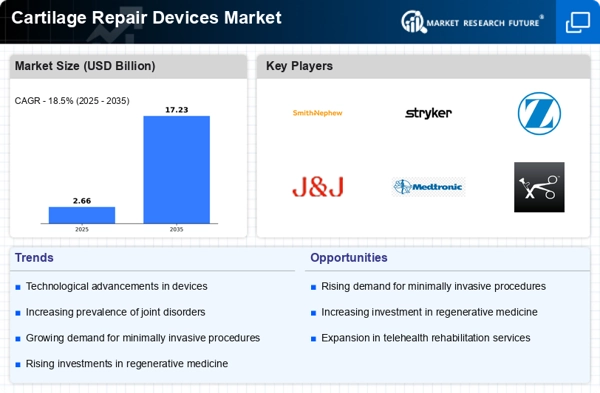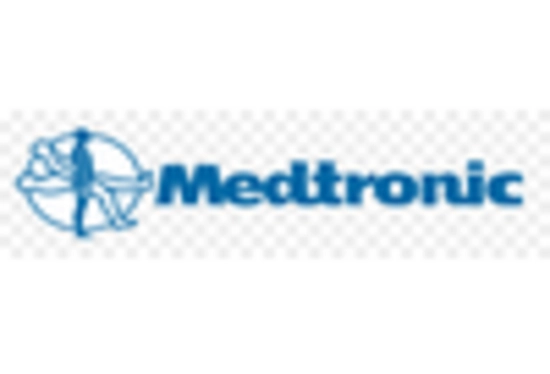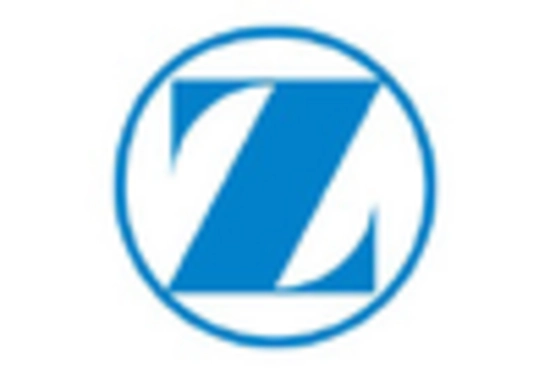Government Initiatives and Funding
Government initiatives aimed at improving healthcare infrastructure and funding for orthopedic research are pivotal drivers of the Cartilage Repair Devices Market. Various governments are investing in healthcare technologies to enhance patient care and treatment outcomes. For instance, funding for research into innovative cartilage repair techniques is on the rise, which may lead to the development of new devices and therapies. These initiatives not only support the advancement of the Cartilage Repair Devices Market but also encourage collaboration between public and private sectors. As a result, the market is expected to experience growth fueled by increased investment in research and development, ultimately leading to improved treatment options for patients suffering from cartilage damage.
Rising Incidence of Osteoarthritis
The increasing prevalence of osteoarthritis is a primary driver for the Cartilage Repair Devices Market. As populations age, the incidence of osteoarthritis rises, leading to a greater demand for effective treatment options. According to recent estimates, osteoarthritis affects millions worldwide, with projections indicating that by 2030, nearly 67 million adults in the United States alone will be diagnosed with this condition. This growing patient population necessitates innovative cartilage repair solutions, thereby propelling the market forward. The Cartilage Repair Devices Market is likely to witness substantial growth as healthcare providers seek advanced technologies to address the needs of these patients. Furthermore, the economic burden associated with osteoarthritis management underscores the urgency for effective cartilage repair interventions, which may further stimulate market expansion.
Growing Awareness and Patient Education
The increasing awareness of cartilage repair options among patients is driving the Cartilage Repair Devices Market. Educational campaigns and resources provided by healthcare professionals are empowering patients to seek treatment for cartilage injuries. As individuals become more informed about the available options, they are more likely to pursue interventions that can improve their quality of life. This heightened awareness is reflected in the rising number of consultations and procedures related to cartilage repair. Furthermore, as patients advocate for their health, the demand for innovative and effective cartilage repair devices is expected to grow. The Cartilage Repair Devices Market is thus positioned to expand, as patient education initiatives continue to play a crucial role in shaping treatment decisions.
Technological Innovations in Cartilage Repair
Technological advancements play a crucial role in shaping the Cartilage Repair Devices Market. Innovations such as 3D printing, biomaterials, and regenerative medicine are revolutionizing the way cartilage injuries are treated. For instance, the development of bioactive scaffolds that promote cell growth and tissue regeneration is gaining traction. These advancements not only enhance the efficacy of treatments but also improve patient outcomes. The market is projected to grow at a compound annual growth rate of approximately 10% over the next five years, driven by these technological innovations. As research continues to evolve, the Cartilage Repair Devices Market is expected to expand, offering new solutions that cater to the diverse needs of patients suffering from cartilage-related ailments.
Increasing Sports Injuries and Active Lifestyles
The rise in sports-related injuries is significantly influencing the Cartilage Repair Devices Market. As more individuals engage in sports and physical activities, the incidence of cartilage injuries has escalated. Reports indicate that sports injuries account for a substantial percentage of all orthopedic injuries, with cartilage damage being a common consequence. This trend is particularly evident among younger populations, who are increasingly participating in high-impact sports. Consequently, there is a growing demand for effective cartilage repair solutions to facilitate quicker recovery and return to activity. The Cartilage Repair Devices Market is likely to benefit from this trend, as healthcare providers and athletes alike seek advanced treatment options to address cartilage injuries and enhance performance.


















Leave a Comment